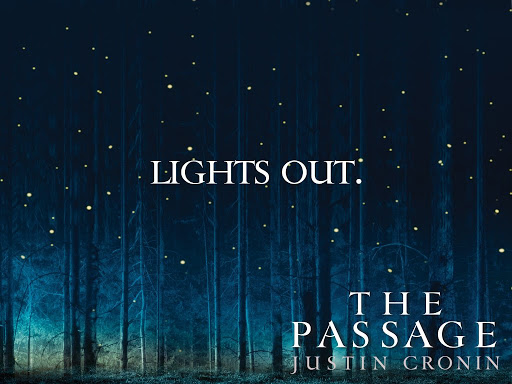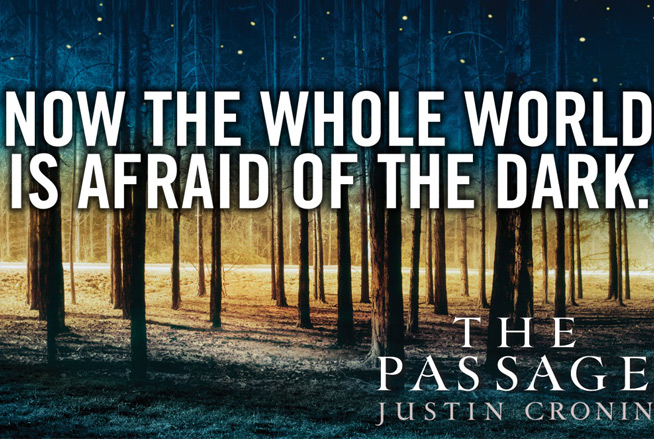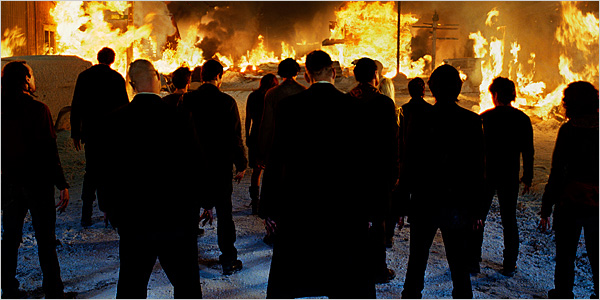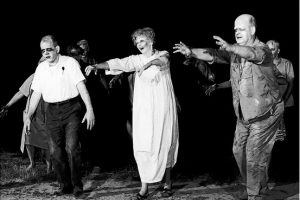The question I’ve been asking myself is: Can you make a movie about postmodernity? Or rather: Can you make a postmodern movie about postmodernity? Can you make a movie about a historical period in a style that isn’t designed for recording history? And our hunch has got to be no. An artwork that is postmodern should not be able to register its own postmodernity, should not be able to draw attention to what is historically novel about its own condition.
Such, then, is the unexpected interest of Brian De Palma’s Body Double, from 1984—that it might be the movie that invites us to revise this conclusion. Jameson was able to show how historical thinking runs dry even in a novel, Ragtime, that on the face of it seems fully and commitedly historical. The task now is to reverse this procedure by scanning postmodernism’s amnesiac mediascape to see what historical signposts have escaped unflattened within it. If we set out from the idea that postmodernism isn’t just a mistake—if we posit, perhaps just as a thought experiment—that it is on some level a faithful report on lives lived out in the society of the spectacle, then we should be able to discover, amidst its intertextuality and in jokes and obligatory ironies, a descriptive or materialist moment. Once you’ve said that postmodernism elevates meta-fiction to the status of realism, you can, if you choose, read even meta-fiction as realist.
Body Double, I would grant, is not a movie that anyone would spontaneously describe as reportage—a movie, rather, so fully of the early ‘80s that you can’t even summarize its plot without pointing out how goddamn postmodern it all is. You call from the pulpit that postmodernism went in for citations or flaunted its unoriginality … and I’ll respond that Body Double is a Hitchcock vs. Hitchcock mashup of Rear Window and Vertigo. You call that postmodernism erased the line between high art and low … and I’ll say that Body Double has a naked lady where Grace Kelly used to be. It’s the movie, in other words, that cemented De Palma’s reputation as his generation’s trash Hitchcock. And so here’s what Rear Window would look like if its title were a dirty pun: An out-of-work actor is given a place to stay in Los Angeles by a new friend, another actor who’s going to be out on the road doing repertory work. Each night he’s in this new place he watches a woman in a building across the way strip down and put her hand between her legs, and before long he realizes she’s in trouble: a man she knows is pushing her around, plus someone else seems to be watching her, too. The actor, fascinated and feeling responsible towards his masturbating neighbor, starts following the woman around, whereupon he discovers that the other voyeur is also on her tail. He approaches her, reaches out, tries to talk, but can’t get through. The third night in, he is stuck watching as Voyeur #2—an oversized Chicano fella who looks something like Danny Trejo without the moustache—breaks into her apartment and murders her with a jackhammer. He reports this all to the police, who don’t suspect him of the crime, but still denounce him for a pervert. Then comes a chance clue: Stanching his grief with porn, the Tom notices a stripper-starlet doing the same distinctive, clam-happy dance he’d seen out his window and realizes that something isn’t right, that there must have been two women where he’d thought there was only one. So he pretends to be a porn actor in order to gain access to the actress; and then, once close, pretends to be a porn producer in order to get her alone and ask her some questions, whereupon it all falls into place. He’s been set up: His new friend—the other actor—hired the porn star to grind in that lit window, the idea being to keep his gaze fixed on the facing apartment so that he would see “the Indian” kill the woman—the other woman; the real woman—and the police wouldn’t suspect the actual culprit, who is of course the hero’s friend. What our guy doesn’t work out until the last minute, during a brawl over an open grave, is that there is also no Indian, because the murderer was really just the new friend in blame-the-darkie brownface.
One of the things that is most likeable about Body Double is that it is fully pretending to be stupid, which makes it in this one respect not like the Tarantino movies it otherwise resembles, since these always pause to parade their intelligence. De Palma’s movie you could get through convinced only of its tastelessness. There is, however, a spoofiness to the thing—a preoccupation with its own movie-ness—that indicates a secondary program beyond the baring and butchering of flesh. All I mean to say is that Body Double never lets you forget that you are watching a movie, and this more than anything has earned it the tag “postmodern.” It begins and ends on a movie set; its first line is spoken by an unseen director, which might be enough to make newcomers watching it on DVD think they’ve accidentally turned on the commentary track; a grand old deco hotel on Hollywood Boulevard is filmed to look like Dracula’s castle; when characters drive, the movie has them in stationary cars against back projections, such that one begins to hallucinate Doris Day in the passenger’s seat; the early-morning window in one shot, its light still without tint or hue, might be an old black-and-white movie thrown up onto yet another screen; when two characters kiss outdoors, the movie shifts from live background to a washed out rear projection of same; the opening credits are all bucket-of-blood, creature-feature retro-sleaze, like something off the cover of a Cramps album.
So there it is—some of the evidence that this is meta-film. The standard line on this would frame its point in epistemological terms: The movie is giving us a crash course in skepticism, teaching us not to mistake representations of objects for the objects themselves or at least taunting us for our compulsive committing of that error. Characters wander out in front of painted backdrops, gesso-and-canvas mountains with the real San Gabriels still visible in the background, when of course by “real” I mean “filmed,” which is precisely the correction the movie is demanding that I make: Be careful what you call real. The stylistic tricks have an utterly straightforward relationship back to the plot, because the movie’s viewers and its hero are in the same position—just so many watchers. The character has to work out that what he’s watching is just a staging—he’s been duped—and the movie is constantly reminding us of the same point—that we are suckers to what we see—but our version of that point comes in a radicalized form, since the character, at least, is allowed a moment of genuine insight; allowed, that is, to look behind the curtain and encounter there something he can call truth. He has solved a mystery. But if we’ve twigged to the movie’s games, then we will have to conclude that even this insight—this uncovered reality—has been scripted and staged … for us … by a movie. We never get to go back behind or to the bottom of anything.
This, again, is the standard line, and it comes in one major variation, which is ethical, in which case you might conclude that you are fixated on images not because you’re a philosophical realist but because you’re a reprobate. It is, indeed, one of Body Double’s many charms that it silently classes positivists among the debauched. The main character is, of course, caught out as voyeur, and since the movie goes out of its way to establish the correlation between him and us—as people who hang about in dark rooms watching other people go about their business—then we are sooner or later bound to realize that we are his accomplice and co-ogler, just one of the title’s many doubles. “You’re a peeper,” the cop tells him, therefore you. “In my book, that’s a pervert and a sex-offender”—which is one way to make clear to viewers that their sincere concern for the woman at the moment of her killing—their wanting to call out to her, their wanting her to escape the murderer’s clutches—was messily entangled with their delight at having had a good look at her nipples. De Palma, it should be noted, saves the movie’s most salacious softcore shots for the movie’s very end, by which point the viewers can consider themselves thoroughly pre-accused. Either way, though, whether we follow the epistemological line or the ethical one, we get to say that Body Double is a movie about movies and that this vitiates cinema’s usual reality effect … brackets its referentiality … voids the claim, implicitly made by nearly every film, to be about something other than movies.
Now that line works as far as it goes, but it’s not enough. Body Double is about a spectator who gets involved in the events he’s been watching—this is what it most shares with Rear Window. And that meditation on spectators—on what it means to be part of an audience, on the limitations and obligations of that position—is certainly what makes the movie meta-. But it simultaneously introduces into the film a certain unconventional realism, because “the spectator” is not an already established movie type, not a cowboy or a gumshoe or a rogue cop. In the place of these heroes, all of them more or less mythical, the movie has inserted someone pathetically like us, somebody whose first impulse is always to stand and stare and only belatedly to punch someone. Body Double’s project is to take the spectator and make him the hero in a crime thriller, on the understanding that the spectator is a historically novel and rather alienated social position, truncated, passive, precisely not heroic. The movie is to that extent calling out genre film on its basic lie or paradox: Most blockbuster movies present us with a world bustling with dynamic people, mostly men, riding in, rumpusing, getting ‘er done, and yet even this incessant display of intact heroism, far from modeling for us a masculinity we can adopt in turn, will tend to make of us only bystanders. Most movies expect us to lionize the Deed from a position of mass immobility, lined up in inert rows.
Body Double wants to tackle this problem head on. How would a genre film have to change if it took as its raw material the real human stuff of the present? Or more broadly: In the society of the spectacle, in which we are all onlookers, how does anything ever get done? The movie’s spectactor-hero registers to this extent as an intrusion from the real world, such that we might just about conceive of the film as a Purple Rose of Cairo in reverse—or as a sinister Pleasantville—a movie, that is, in which someone from the audience has crawled magically onto the screen and has to shuck-and-jive his way through whatever role John Travolta has just vacated. De Palma’s most inspired move, back in 1983, was simply to cast a bad actor in that part, or if you like, to miscast a bit player in a starring role—an actor more typically associated with one-off appearances on LA Law or Murder, She Wrote, a bonier Bill Maher, we might say now. This is the movie’s most specifiable intrusion, its most overt tampering with your complacent expectations: The schmo is occupying a role that you had thought would go to someone else—Harrison Ford, maybe, or Michael Douglas—not, at any rate, to one Craig Wasson. You could call the character one of Hitchcock’s ordinary men, but then you’d still have to make clear: He’s really ordinary … and not just Cary Grant standing in for average.
The movie’s first order of business, then, is to take its hero and establish him as a schlemihl and human yo-yo. Some of its devices are entirely conventional: He gets fired, discovers his girlfriend cheating on him, is variously dogged and dressed down. The problem with setting a movie in LA is that there are no rain puddles for taxis to splash on a sad sack’s best suit. One of its devices in this regard is moderately interesting: During a guided memory at an acting lesson, he is told to cry out—to wail in what is in some complicated way his own voice—and he can’t do it … can’t find the air … can’t even find a sound inarticulate. It’s the sort of shift Jameson would want us to note: from The Scream to the un-scream, from a world of suffering to a world so stage-managed by spectacle that you can’t even holler if it’s not in the script. And then one device along these lines is really very fine: The movie begins with the hero working on a cheap horror movie, as its monster, except whenever it comes time to crawl from the tomb, he seizes up. Within the inherited vocabulary of the drive-in movie, that’s an ingenious image of castration: a vampire who cannot leave his coffin, the undead about to lose its animating prefix, and also an actor who cannot heed the call to “Action!”
And then this now gets at something deep in the movie: The first thing we see in Body Double is nothing happening, and we will immediately want to generalize the point: What’s missing from the movie is die Tat: feats, exploits, interventions. The only thing the hero is good at doing is watching. The movie itself, meanwhile, is at its best when trying to find ways of signaling its hero’s scopophilia, and this in a way that underscores its resemblance to the movie-going that anyone watching the thing is by definition doing right at that very moment. De Palma is so adept at this particular provocation that it can leave you a little contemptuous of Hitchcock, who, one now realizes, was making things easy for himself in Rear Window when he strapped Jimmie Stewart to a chair, dimmed the lights, and then furnished him with a multiplex of illuminated oblongs across the way. The cinematic likeness in those sequences could hardly be more obvious. But De Palma gets his hero up off the upholstered seat, puts him on the move, sends him out into the city, following the woman, and still manages to call to mind movie-going, for which he has to find an accordingly more elaborate set of visual approximations. One in particular stands out: The hero follows the neighbor woman to Santa Monica; climbs up to a balcony on a beach house; and then watches while she makes her way down the same house’s lower terraces and then out onto the sand, at which point the balcony he’s standing on reclassifies itself, inconspicuously, as a gallery or theater box. The effect would be easy to miss, except at one point he leans in as though to talk to her from afar, his mouth moving silently to form unspoken words, which is recognizably the behavior of somebody stopping himself from talking to a movie: Watch out. There’s somebody behind you.
If we call that example #1, we can promptly add two more.
2) During that same acting lesson, the hero is telling a story about playing hide-and-seek as a child—or rather he’s re-experiencing the ordeal of a game gone wrong: He’d gotten wedged behind a refrigerator, pinned into his hidey-hole, and was frozen with fear. So yes, hide-and-seek … a discovery game, which is thematically relevant … the movie is what you might call “highly designed.” But more important, the hero is reliving this childhood paralysis and has gone to stone on the classroom stage, and the teacher, trying to snap him out of it, shouts: “You have to act!” What this means is, of course, entirely unclear. The entire scene has been arranged to bring out the everyday paradox of that word in English—“to act”—which means both “to really do something” and “to not really do something.” The voyeur-hero in Rear Window was a photographer by trade, a professional watcher. It is another of De Palma’s small innovations over Hitchcock to make his voyeur an entertainer, somebody who works in front of the camera, and so to allow him to encapsulate the only two social positions that are left to us in the society of the spectacle: the spectator and the performer in one. The epigrams start writing themselves: Acting swallows up the category of the Act. The actor is the one who will never act. In postmodernity, “action” is a type of movie, and an “act” is one third of a play.
3) The movie’s final showdown is an elaborately dry gag. The hero has been tossed into a freshly dug grave, and again his claustrophobia sets in. From this moment on, two things will stand out. First, we get the hero’s POV from underground; he’s looking up at the rectangle of the pit’s opening, which, for no diegetic reason, has been floodlit—lit to white—such that it resembles a blank movie screen, with our guy again in darkness and the killer’s figure looming out from the sky’s fabric. The image has to be understood as a taunt or a warning or a buzzer attached to your theater seat. The cinema is a grave; if you remain a spectator you are going to die. Second, the movie carries its contrivance so far that the hero doesn’t actually contribute to his own survival. At just the moment when you think he is going to absorb the imperative to act and so model for you what it might mean to leap for once from your living room sofa, you and he learning together to shed the passivity of the spectator—a dog appears nearly out of nowhere; jumps the murderer; and pulls him to his death over the face of a dam. The Act puts in one final non-appearance. That sequence condenses into three short shots one of the things about this movie that is hardest to get at, which is its rather bracing willingness to disappoint. For Body Double is, by most of the usual standards, a pretty lousy crime thriller: a collection of set pieces variously abridged and aborted, resolved to perform upon itself and at the level of genre the castration that it laments in what for structural reasons alone I persist in calling its hero. Try to imagine a Dirty Harry movie in which Clint Eastwood had been replaced by an inanimate object, a box elder, say, or a chaise lounge.
And yet it is this very badness that is the movie’s best thing—its carrier of history—its invitation to memory …






















